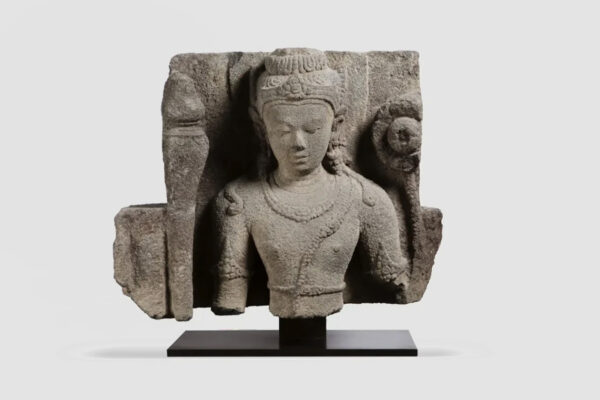The different types of lacquer: recognizing them
Typologies of different lacquers
Several types of lacquer exist, each with its own characteristics and estimates. Several are often linked to a particular country.
Carved lacquer: the finesse and depth of Chinese lacquer.
Carved lacquer is one of the most refined and emblematic forms of Chinese lacquer. Several layers are applied (up to 30 or 40) and sanded, before the whole is carved to reveal the lower layers.
For example, a rectangular box from the Jiaqing period fetched 50,000 euros. Its price was justified by the exceptional Baizi tu (Hundred Boys) decoration, its age and state of preservation. Conversely, a carved cinnabar lacquer bonbonnière fetched 80 euros at auction.
These objects, when antique or signed, are highly prized not only for their beauty but also for their symbolism, particularly in Chinese culture.
Mother-of-pearl inlaid lacquer
This technique involves cutting the mother-of-pearl into delicate shapes, which are then integrated into the lacquer to create intricate patterns, often inspired by nature, such as flowers or landscapes. For example, a mother-of-pearl-inlaid lacquer box from the Ming dynasty, adorned with detailed floral motifs, can be worth between 15,000 and 20,000 euros.
Makie lacquer, Japanese luxury
Makie is a Japanese technique in which gold or silver powder is applied to wet lacquer to create patterns. This technique is often used for luxury objects, from tea caddies to trays.
An exceptional box from a private collection recently sold for 35,000 euros at Bonhams, showcasing Japanese craftsmanship and aesthetics. Another example, a nashiji lacquer writing case decorated with hira makie and taka makie, dating from the Edo period, was estimated at between 12,000 and 15,000 euros.
Kintsugi, the art of repair
Kintsugi is an artistic practice that uses lacquer mixed with gold powder to repair broken objects, transforming imperfections into works of art. This art form has been used by Japanese tea masters since the 15th century.
For example, a 17th-century porcelain vase, meticulously repaired using this technique, sold at auction for 8,500 euros.
Vietnamese lacquer, Son mài: between modernity and tradition
The son mài technique is used in Vietnam by modern and contemporary artists. Lacquer is combined with mother-of-pearl, pigments, etc. A contemporary son mài lacquer painting can fetch auction prices of up to 700,000 euros. A panel by Tran Phuc Duyen fetched 377,000 euros at Millon.
Joseon lacquer in Korea
Korean lacquerware, especially during the Joseon dynasty (1392-1910), is famous for its intricate floral motifs and use of mother-of-pearl. Lacquer objects from this period are often adorned with delicate, refined motifs.
A casket from the Joseon dynasty fetched 12,500 euros, attracting collectors for its excellent condition and the quality of its workmanship.
Which type of lacquer is the most expensive?
Today, Vietnamese works by artists of the Hanoi school are the most expensive. Generally speaking, rare works in good condition have seen their prices rise in recent years. Works of medium to low quality have seen their prices fall.
- Chinese lacquerware is valued at up to 50,000 euros, but many objects sell for just a few hundred euros.
- Japanese lacquers, particularly Makie lacquers, are highly prized and regularly sell for several thousand euros.
- Vietnamese lacquerware is booming, with records reaching up to 900,000 euros (for a work by Pham Hau).
Our areas of expertise
OUR FAQS
Does the price of a lacquer vary according to its country of origin?
Yes, of course, lacquer prices vary according to the technique used and therefore often according to geographical origin.
What type of lacquer can Asium estimate?
Thanks to a team of specialists, Asium has expertise in all lacquers and in all their forms: objects, paintings, furniture, etc.
How much does lacquered furniture cost?
Antique furniture can fetch high prices, as in the case of an 18th-century armoire sold for 34,000 euros at Millon. Modern furniture, such as a table or cabinet, created at the beginning of the 20th century, sells today for only around a hundred euros. Be careful, if your piece is signed or of exceptional quality, the estimate will be revised upwards.
Why ask for a free lacquer estimate?
Lacquer was very popular at the beginning of the 20th century, and can still be found in many homes and apartments. Given the wide price range, from 100 euros to 900,000 euros, it’s best to avoid mistakes and seek expert advice.
Previously appraised by Asium
The Asium estimation service is...

Simple
and free
A few photos of your work, a few words of description and you're all set !

Fast
but not too fast
Our experts are serious, they take the time to research and get back to you within a week.

Reliable
and confidential
Our auctioneers are the Sherlock Holmes of the art market.

































